
Villain
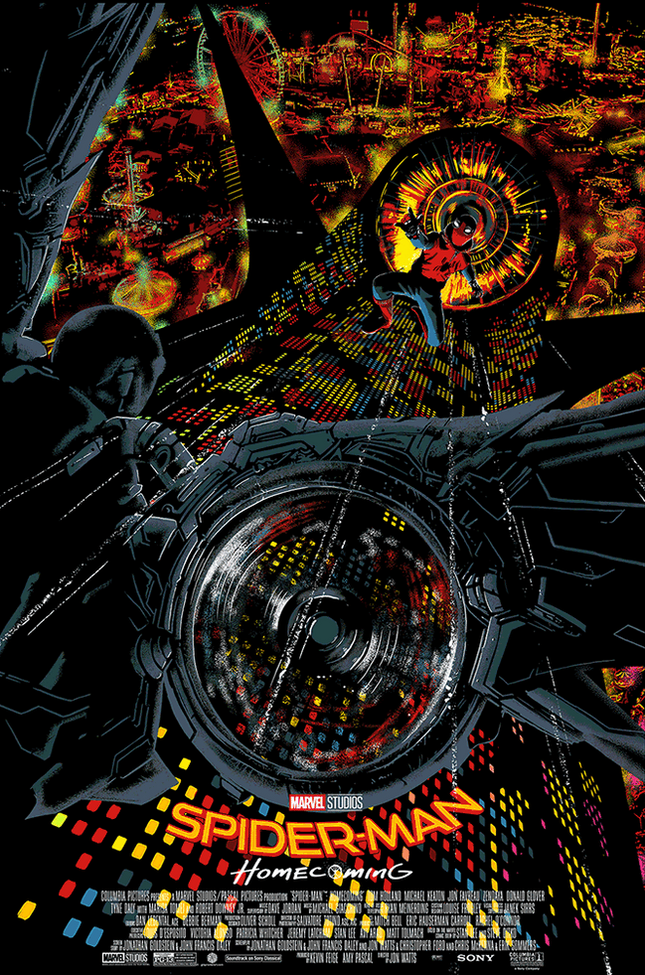

Raid71 Spider Man Homecoming Foil Silkscreen Print by Raid71
Spider-man Homecoming Foil Silkscreen Print by Raid71 Hand-Pulled on Holofoil Fine Art Paper Limited Edition Pop Street Art Artwork. 2023 Signed & Numbered Limited Edition of TBD Artwork Size 24x36 Holographic Foil Silkscreen Print by Raid71 The Spider-Man Homecoming Foil Silkscreen Print by Raid71 is a limited edition art print featuring an illustration of the iconic Marvel superhero Spider-Man. The print is created using the silkscreen printing technique, which involves applying ink through a mesh screen onto paper or another material. This particular print is unique because it also features foil accents, which give the artwork a shimmering, metallic effect. The print measures 18 x 24 inches and is hand-numbered and signed by the artist, Raid71. The artwork depicts Spider-Man in his classic red and blue suit, swinging through the streets of New York City with his web-slinging abilities on full display fighting Adrian Toomes aka Vulture. The background features a stylized cityscape with bold, graphic lines and holographic rainbow multi vibrant colors, adding to the dynamic and energetic feel of the piece.
$247.00
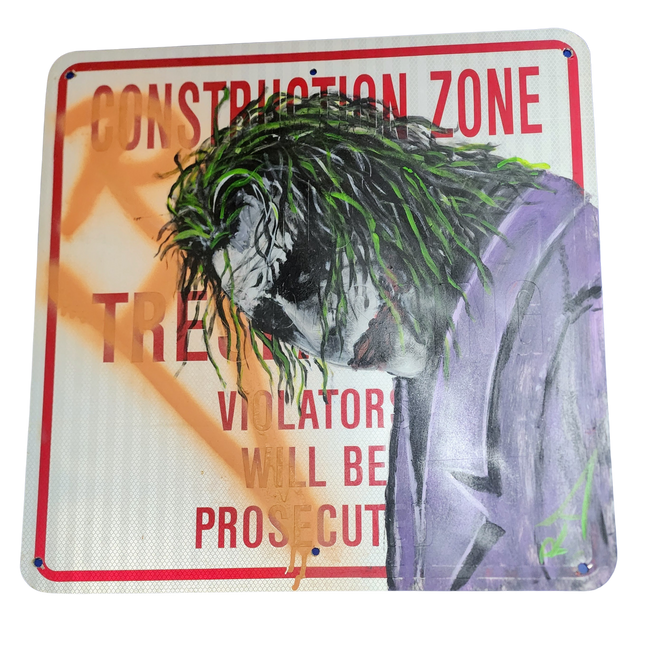
RD-357 Real Deal Ledger Joker Construction Street Sign Painting by RD-357 Real Deal
Heath Ledger Joker Construction Zone Original Street Sign Painting by RD-357 Real Deal One of a Kind Artwork on Real Metal NYC New York Construction Zone No Trespassing Street Sign by Graffiti Art Pop Artist. 2012 Signed Mixed Media Acrylic & Spray Paint on Reclaimed NYC New York Construction Zone No Trespassing Sign Painting Original Artwork Size 24x24 Batman Villian Played by Heath Ledger in the Movie as Joker Looking at the Viewer. RD Tag in Rust Red. RD-357's Heath Ledger Joker: A Fusion of Street Pop Art and Iconography The Heath Ledger Joker Construction Zone original street sign painting by RD-357, also known as Real Deal, encapsulates the essence of street pop art through its provocative use of public signage repurposed for artistic expression. Created in 2012, this mixed media acrylic and spray paint artwork transforms a New York City construction zone 'No Trespassing' sign into a canvas, depicting the iconic Batman villain played by Heath Ledger in a way that both challenges and captivates the viewer. Contextualizing RD-357's Artistic Approach RD-357, an artist whose real name remains elusive in the true spirit of street art anonymity, is known for his gritty interpretations of pop culture figures on unconventional canvases. This particular artwork measures 24x24 inches and is a testament to street art's versatility, pushing beyond traditional boundaries. RD-357 draws upon the anarchic spirit of the Joker, using a symbol of law and order – a construction sign – to present an image of chaos and rebellion. The irony is palpable; the sign, which once stood as a warning against unauthorized entry, now invites viewers to engage with the art in a personal, almost aggressive manner. Symbolism and Impact in RD-357's Joker Artwork This piece is not just a portrait; it is a statement. By choosing Heath Ledger's Joker, RD-357 taps into the collective consciousness of a society fascinated by the anti-hero archetype. Ledger's portrayal of the Joker was posthumously celebrated, and his death in 2008 left a cultural imprint that RD-357 leverages in this artwork. The juxtaposition of the Joker’s figure against the backdrop of a New York construction sign speaks volumes about the chaotic undercurrents within the perceived order of urban life. The use of mixed media, with acrylic and spray paint, highlights street art's raw, visceral nature, while also paying homage to the vibrancy of pop art. The viewer is confronted with the Joker's gaze, which, coupled with the bright warning colors of the construction sign, creates an unsettling yet magnetic presence. This interaction compels the audience to contemplate the layers of meaning behind the piece – from transforming public property into a medium for personal expression to the dialogue between art and spectator that challenges societal norms and the very definition of public space. In conclusion, RD-357's Heath Ledger Joker on a New York City construction sign is an outstanding example of how street pop art can merge cultural iconography with subversive messaging. Through this piece, the artist immortalizes a beloved film character and raises questions about authority, ownership, and the role of art in public discourse. The artwork remains a one-of-a-kind testament to the power of graffiti art to redefine spaces and provoke thought long after the paint has dried.
$3,000.00
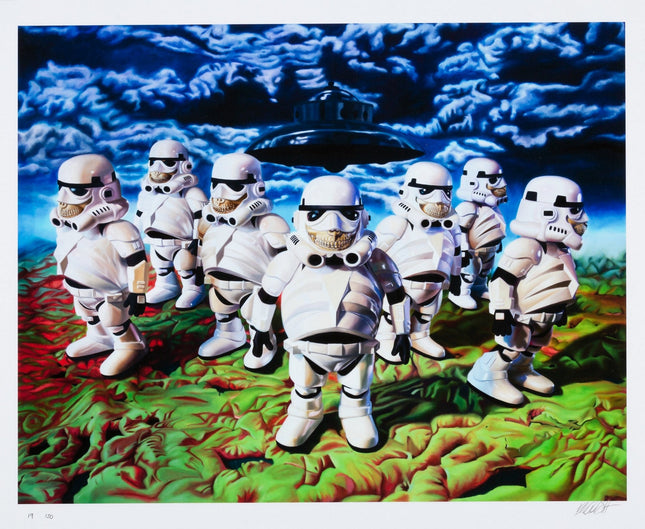
Ron English Grin Guard Archival Print by Ron English
Grin Guard Limited Edition Archival Pigment Fine Art Prints on Moab Entrada Fine Art Paper by Graffiti Street Art and Pop Culture Artist Ron English. 2021 Signed & Numbered Limited Edition of 150 Archival Pigment Print in Colors on Moab Entrada Fine Art Paper Artwork Size 24x20 "Grin Guard" stands out as a compelling exemplar of Ron English's artistic vision, where he seamlessly integrates elements of satire, pop culture, and street art. Known for his critical and humorous take on contemporary society, English's creation is a limited edition series comprising 150 signed and numbered prints, each rendered with archival pigment on Moab Entrada Fine Art Paper. This paper is renowned for its ability to present a broad spectrum of vibrant colors and preserve the fine details of the artwork, making it an ideal medium for English's detailed style. Sized at 24x20 inches, each piece in this series is a work of art and a collector's item. This print features a phalanx of stormtroopers from the iconic "Star Wars" franchise, each donning a different expression of Ron English's signature grin—a recurrent motif in his work that often symbolizes the subversive undercurrents of pop culture. Against a backdrop that evokes a surrealist landscape beneath an ominous UFO, the scene is familiar and jarringly otherworldly. This juxtaposition is emblematic of English's approach, which often places recognizable characters in unexpected contexts to critique and comment on media, consumerism, and the corporatization of American culture. Through "Grin Guard," English explores the concept of the 'trooper' not just as a faceless enforcer but as a being with an individual, if concealed, identity. The grinning skulls emblazoned on their helmets suggest a macabre sense of mortality and individuality within the conformity of their ranks. This piece is a powerful commentary on identity and anonymity, particularly within mass media and entertainment, where characters often become mere extensions of their fictional universes rather than being perceived as reflections of human nature. Ron English's work continues to challenge viewers, using the accessible mediums of street and pop art to provoke thought and discussion. "Grin Guard" is no exception, offering not only an aesthetic that resonates with fans of these genres but also conveying a more profound message about the complex interplay between individuality and cultural iconography. Through such works, English affirms his status as an innovative artist who can blur the lines between fine art and the rebellious spirit of street art.
$415.00
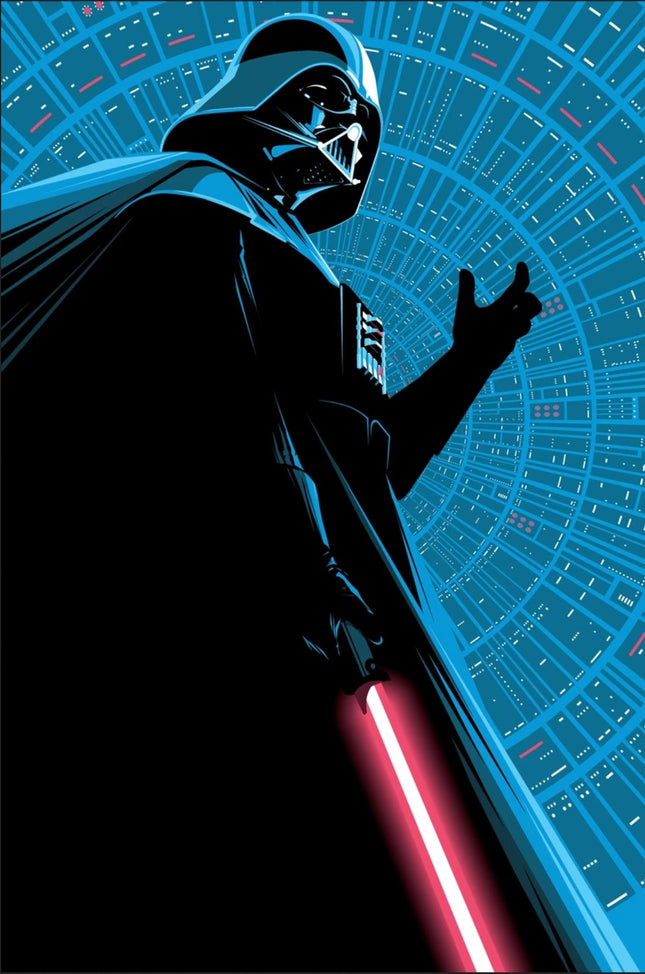
Craig Drake Vader Metal Silkscreen Print by Craig Drake
Vader- Metal Limited Edition 4-Color Hand-Pulled Silkscreen Print on Metal Sheet by Craig Drake Graffiti Street Artist Modern Pop Art. Darth Vader from Star Wars TV, Movies & Games on Metal Sheet.
$406.00
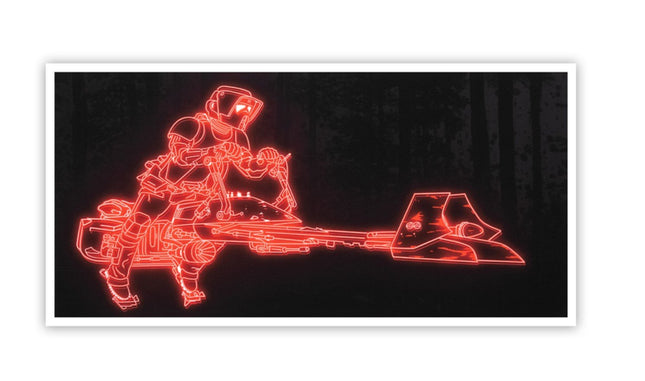
Adam Fujita Maul Speeder Archival Print by Adam Fujita
Maul Speeder Archival Pigment Fine Art Limited Edition Print on 290gsm Moab Entrada Paper by Artist Adam Fujita, Street Pop Art Graffiti Legend. 2022 Signed & Numbered Limited Edition of 15 Size 24x12 Adams recent neon-style work has been an exploration of protest and resistance through the use of the medium of street art and the internet.
$337.00







